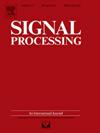基于ReLU和硬阈值追踪算子的非负稀疏信号恢复
IF 3.4
2区 工程技术
Q2 ENGINEERING, ELECTRICAL & ELECTRONIC
引用次数: 0
摘要
在人脸识别、DNA 微阵列和光谱解混合等各种应用中,涉及非负稀疏近似的线性逆问题至关重要。基于 ReLU 算法的最新进展,如基于 ReLU 的硬阈值法(RHT)和动量增强自适应阈值法(MBAT),通过利用整流线性单元(ReLU)与阈值算子相结合来产生非负稀疏解,从而解决了这一问题。尽管取得了这些进展,但在实现高恢复性能和更快收敛方面仍存在挑战。为了解决这些问题,我们提出了一种基于 ReLU 的非负稀疏信号恢复新算法,称为基于 ReLU 的硬阈值追求(RHTP)。具体来说,RHTP 将 ReLU 集成到硬阈值追寻框架中,以实现非负稀疏信号的高效恢复。我们基于受限等几何特性,推导出确保 RHTP 生成的稀疏信号稳定恢复的充分标准。此外,我们提供的理论分析表明,RHTP 算法比 RHT 算法收敛更快。数值实验证明,RHTP 在恢复二进制稀疏信号方面优于现有算法,在恢复非负稀疏高斯信号方面的性能与最先进的 MBAT 算法相当。此外,经验结果表明,与其他方法相比,RHTP 的收敛速度更快。此外,在耶鲁人脸数据集上,RHTP 比其他非负稀疏信号恢复算法获得了更高的分类准确率,证明了它在人脸识别方面的有效性。本文章由计算机程序翻译,如有差异,请以英文原文为准。
Non-negative sparse signal recovery using the integration of ReLU and hard thresholding pursuit operators
Linear inverse problems involving non-negative sparse approximations are essential in various applications such as face recognition, DNA microarrays, and spectral unmixing. Recent advancements in ReLU-based algorithms, such as ReLU-based hard thresholding (RHT) and momentum-boosted adaptive thresholding (MBAT), solve this problem by leveraging the rectified linear unit (ReLU) in combination with thresholding operators to produce non-negative sparse solutions. Despite these developments, challenges persist in achieving high recovery performance and faster convergence. To address these issues, we propose a novel ReLU-based algorithm for non-negative sparse signal recovery, termed ReLU-based hard thresholding pursuit (RHTP). Specifically, RHTP integrates the ReLU within the hard thresholding pursuit framework to enable efficient recovery of non-negative sparse signals. We derive sufficient criteria for ensuring the stable recovery of sparse signals generated from RHTP based on the restricted isometry property. Additionally, we provide a theoretical analysis showing that the RHTP algorithm converges more rapidly than the RHT algorithm. Numerical experiments demonstrate that RHTP outperforms existing algorithms in recovering binary sparse signals and delivers comparable performance to the state-of-the-art MBAT algorithm in recovering non-negative sparse Gaussian signals. Furthermore, empirical results demonstrate that RHTP exhibits faster convergence compared to other methods. Moreover, RHTP achieves higher classification accuracy than other non-negative sparse signal recovery algorithms on the Yale Face dataset, demonstrating its effectiveness in face recognition.
求助全文
通过发布文献求助,成功后即可免费获取论文全文。
去求助
来源期刊

Signal Processing
工程技术-工程:电子与电气
CiteScore
9.20
自引率
9.10%
发文量
309
审稿时长
41 days
期刊介绍:
Signal Processing incorporates all aspects of the theory and practice of signal processing. It features original research work, tutorial and review articles, and accounts of practical developments. It is intended for a rapid dissemination of knowledge and experience to engineers and scientists working in the research, development or practical application of signal processing.
Subject areas covered by the journal include: Signal Theory; Stochastic Processes; Detection and Estimation; Spectral Analysis; Filtering; Signal Processing Systems; Software Developments; Image Processing; Pattern Recognition; Optical Signal Processing; Digital Signal Processing; Multi-dimensional Signal Processing; Communication Signal Processing; Biomedical Signal Processing; Geophysical and Astrophysical Signal Processing; Earth Resources Signal Processing; Acoustic and Vibration Signal Processing; Data Processing; Remote Sensing; Signal Processing Technology; Radar Signal Processing; Sonar Signal Processing; Industrial Applications; New Applications.
 求助内容:
求助内容: 应助结果提醒方式:
应助结果提醒方式:


